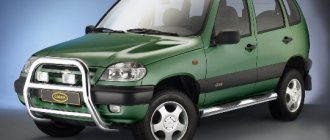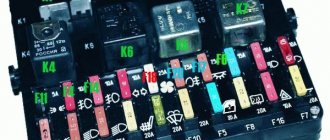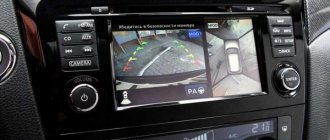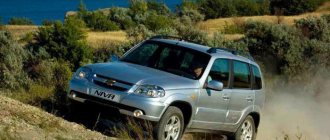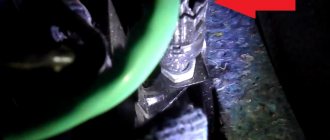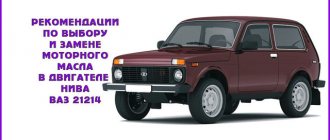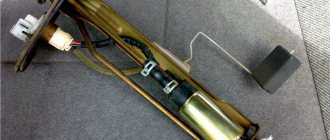The Chevrolet Niva has repeatedly undergone modernization, which has increased the convenience and comfort of driving, but the nuances with the transmission and engine have not yet been resolved. About 99% of the former owners of this vehicle remain dissatisfied, while only those who recently purchased it praise the car.
Careful and regular maintenance, which should not be neglected from the first days of purchase, helps correct this trend. To repair a Niva Chevrolet with your own hands as rarely as possible, immediately after purchase, tighten all the bolts and lubricate the door hinges and locks, otherwise you will encounter problems within the first thousand kilometers. What else should the driver know about and what are the features of repairing this vehicle?
Getting to know the car
The Niva belongs to the category of elegant SUVs, which were the first result of cooperation between Auto VAZ and General Motors. Driving along a city street can be safely called convenient and comfortable; the car is suitable for going to the country on weekends, or for a family trip with a group of three people. The car also feels at ease where a smooth road is replaced by an aggressive off-road. Among the features of the Chevy Niva are the following:
- new modern monocoque body;
- the engine is not connected to the front axle gearbox;
- all-wheel drive is permanent;
- unification of rear and front driveshafts;
- extension of the intermediate shaft;
- The design of the gearbox drive has been modernized, as well as the brake system.
Weak spots
Advance knowledge about the weak points of the vehicle allows you to carry out repairs on the Chevrolet Niva in a timely manner and prevent major breakdowns. Let's look at them:
- The engine is dull during acceleration, at 30 thousand km. mileage, the seals may already fail. A warranty replacement is possible only if oil leakage is obvious. If the seals are simply wet, you will have to rely on your own strength. The power of the power unit drops when the air conditioning system is activated, which is immediately noticeable when driving along the highway. Poor dynamics and high fuel consumption can be corrected by flashing and doing it better right away. On average, the motor can withstand a resource of up to 250 thousand km.
- The chassis is weak in hubs, torque rods, steering linkage elements, as well as oil seals and ball joints. Often after 30 thousand km. drivers are forced to change the front wheel bearing. The resource of factory racks is also small.
- In terms of the cooling system, it is worth paying attention to the need to replace the antifreeze tank after about a year. With a high degree of probability, it will already leak during this time. Sometimes the pump fails even before the first maintenance.
- The transmission suffers from weak bearings and crosspieces on the driveshaft. The cardans themselves cannot be called a strong point either.
- If we consider the exhaust system, on average it serves flawlessly for about 55 thousand km, but you should be prepared for the fact that if you use low-quality gasoline, the catalyst will fail after just a couple of refills.
- The body, especially the wheel arch area, is susceptible to corrosion. Tangible problems can be noticed as early as 3-4 years. Rust penetrates the scratch within a few days. The paint on plastic elements does not please the eye for a long time.
- In terms of electricians, it is quite rare, but power windows may fail in the first six months. The same resource can be predicted for the starter, belt and generator. The fuel level sensor may display incorrect information if the vehicle position is inclined. Problems also arise with the cooling fan wiring fuses.
- It is better to replace the headlights with LED ones immediately after purchase, otherwise the housing will soon be melted.
- There is almost no sound insulation in the cabin, this is especially noticeable at 100 km/h. Also, many are upset by the lingering of foreign odors into the cabin.
Maintenance of Chevrolet Niva / VAZ 2123 since 2001
A faulty fuse is determined by the failed circuits protected by this fuse, in accordance with the table. The current strength for which the fuse is designed is indicated on its front part, and the fuse number is marked on the body of the mounting block. The new fuse must have the same current rating as the one being replaced.
The layout of relays and fuses is shown in the figure below. The layout of the unit installed on your vehicle may differ from that shown.
Attention
: It is strictly prohibited to install a homemade jumper or fuse of a different rating to replace the blown one.
If the fuse fails again, you need to contact your dealer to find out and eliminate the reasons that caused it to melt.
Additionally, under the instrument panel there are relay blocks with fuses that protect the elements of the injection systems.
The fuses have a current rating of 15 A. An additional 30 A fuse protects the cooling system electric fan circuits.
Fuses do not protect the electrical circuits of ignition, engine start, generator, low beam headlight relay, high beam headlight relay.
| Fuse number (current, A) | Protected Circuits |
| F1 (5 A) | Backlight lamps Trunk lamp Engine compartment lamp License plate lamps Front parking lamps |
| F2 (7.5 A) | Low beam lamp (left headlight) Electrical headlight corrector Motorized corrector |
| F3 (10 A) | High beam lamp (left headlight) |
| F4 (10 A) | Left fog lamp |
| F5 (30 A) | Power window relay Power windows |
| F6 (15 A) | Cigarette lighter |
| F7 (20 A) | Horn relay Horn |
| F8 (20 A) | Rear window defroster relay (contacts) Rear window defroster element |
| F9 (20 A) | Glove box light Windshield wiper relay Windshield wiper switch Windshield wiper motor Headlight wiper relay (contacts) Headlight wiper motors Headlight washer motor |
| F10 (20 A) | Electric door lock control unit |
| F11 (5 A) | Tail lamps Instrument lighting control |
| F12 (7.5 A) | Low beam lamp (right headlight) Corrector motor gearbox (right headlight) |
| F13 (10 A) | High beam lamp (right headlight) |
| F14 (10 A) | Right fog lamp |
| F15 (20 A) | External mirror control unit External mirror control gear motors |
| F16 (10 A) | Relay-breaker for direction indicators and hazard warning lights (in hazard warning mode) |
| F17 (7.5 A) | Individual lighting lamp Immobilizer warning lamp Brake light lamps Additional brake light Interior lighting lamp |
| F18 (25 A) | Reversing lamps Heater fan Windshield washer motor Rear window defroster relay (coil) Rear window wiper relay Rear window wiper motor Rear window washer motor Door lock control unit |
| F19 (10 A) | Turn signal and hazard warning light relay (in turn signal mode) Instrument cluster Differential lock indicator lamp Starter relay |
| F20 (7.5 A) | Rear fog lights Immobilizer |
Body care
The body is the basic and most expensive element of a car. It is made of modern materials and protected from corrosion by high-quality protective agents. The basis for the durability of corrosion protection is laid by the manufacturer, but its effectiveness and duration depend on proper care, climatic conditions, the ecological state of the environment and storage conditions.
To avoid scratches on the paintwork of the body, do not remove dust and dirt with a dry wipe. It is better to wash your car in specialized car washes, which use modern equipment and detergents that are gentle on the paintwork of the body. As a last resort, washing with a low-pressure water jet using a soft sponge and a special car shampoo is allowed.
Attention
: Do not wash your car with the engine running!
After washing, wipe the washed surfaces dry, as when drops of water dry, stains form on the painted surface. In winter, after washing the car in a warm room before leaving, wipe the body and door seals dry, since when the remaining drops freeze, cracks may form in the paintwork and the seals will freeze to the body. It is not recommended to use soda and alkaline solutions, as well as waste water, to wash the car so that the coating does not fade.
Before washing your car, clean the drainage holes in the doors and sills. When washing your car, avoid direct spray of water on electrical equipment, electronic devices, sensors and connectors in the engine compartment. Monitor the condition of the protective covers of detachable connections of electronic units and sensors. If moisture gets in, blow out the detachable connections with compressed air and treat them with a water-repellent agent to protect the contacts from oxidation.
When washing, thoroughly rinse the flanges of the doors, hood, welds and joints of the engine compartment and door openings, since accumulated dirt in these places will lead to the destruction of the protective and decorative coating and to metal corrosion.
If signs of corrosion are detected - corrosion deposits, local swelling of paint, chips, etc. - remove loose and sheet rust with fine emery cloth and treat the cleaned area with a rust converter, according to the instructions for the converter. Then apply primary primer and touch up with enamel. Apply bitumen anti-noise mastic to the ground on the underbody and wheel arches.
Chips and scratches on the paintwork, chips of mastic along the wheel arches and on the bottom are associated with mechanical impacts of an operational nature. Traces of corrosion on welding joints and joints of body parts are superficial in nature and can be removed at the initial stage with polishing pastes. If measures are not taken in a timely manner to eliminate defects in the protective and decorative coating of an operational nature, this will lead to the development of corrosion under the coating layer, its peeling and swelling.
To increase the corrosion resistance of the body, a special anti-corrosion composition is applied to the closed box-shaped cavities of the sills, side members, cross members and other elements of the body base. When operating a vehicle, we recommend restoring the protective coating of hidden body cavities at maintenance facilities during the first year of operation and then periodically once a year.
During vehicle operation, the coating on the underbody is exposed to gravel, sand, and salt. As a result of this exposure, the mastic and primer are erased, and the bare metal rusts. Therefore, regularly monitor the condition of the bottom coating and promptly restore the coating in damaged areas. To maintain the shine of your car's painted surfaces, especially for cars stored outdoors, polish them regularly using polishing pastes. These pastes close microcracks and pores that have arisen during use in the paint coating, which prevents the occurrence of corrosion under the paint layer.
Maintenance frequency
It is worth carrying out repairs and maintenance of the Niva Chevrolet yourself, taking into account the following time periods:
- Check the oil level in the engine block, washer water, brake fluid, and coolant weekly. You should also pay attention to optics, tires and batteries. If the car is not used regularly, the frequency of such checks is 400 km.
- Change the oil filter and oil every 8 thousand km, which will extend the life of the power unit.
- Every 15 thousand km, check the remaining thickness of the front brake pads. The air filter of the ventilation system should also not be ignored.
- Check the condition of the gearbox, washers and electrical systems, suspension, brakes and steering annually. Also lubricate all moving parts on the door panels and trunk. If the SUV is diesel, it is important to monitor the number of crankshaft revolutions at idle. The integrity of engine compartment elements, hoses and connections must also be monitored.
- The air filter must be replaced every 30 thousand km. Do not forget to check how well the drive belts are tensioned. Fuel filters or spark plugs must also be replaced, depending on the type of fuel used. Suspension repairs are not excluded at this time.
- Every 60 thousand km, change the lambda probes and gearbox oil. Repair of body parts is not excluded. Even the slightest scratches cannot be ignored, since corrosion affects this car extremely aggressively. At this stage, the stove can also become weak; you can fix the damage yourself. Even if you service and repair your car yourself, still periodically contact a service station, where they will carry out the necessary measurements of the level of harmful emissions.
DIY Niva-Chevrolet repair (with or without video)
Self-repair of a Chevrolet Niva is a responsible undertaking. A mistake will cost you replacement parts or rebuilding the motor. So saving in the absence of relevant experience is fraught with failure. You may need service assistance. In a car service center, where specialists will carry out competent and high-quality repairs of the car engine and determine the condition of the car using professional diagnostics. You can quickly and easily order a Niva Chevrolet repair service on the Uremont.com website. This is an aggregator that will find you excellent service at a good price. No more tedious reading of reviews and tedious searches for professional help on countless websites. With Uremont you will choose the service with the best rating from users.
Repair features
Repair of the main functional components of the SUV in question has the following features.
Engine
Since the car is specific and the design is not complicated, there will be no surprises in terms of repairs.
Changing the air filter and oil is extremely simple. As for the oil filter, it is located on the side of the block, so it is not easy to get to it. Stock up on 3.75 liters of oil and a hexagon. There is no need even for a lift or a pit, since the ground clearance is quite high. Raising the car makes sense only if there is serious crankcase protection.
A burst expansion tank can also become a problem, and this happens due to its unfortunate shape. Inconsistent lid quality also aggravates the situation.
A burst oil supply tube can cause failure of the hydraulic timing chain tensioner. A clanging metallic sound will be the first sign of such a problem.
In general, the layout for independent implementation of repair and maintenance work under the hood is quite convenient. The only difficulty may be removing the starter, while adding fluid, replacing the air filter or lamps will not create problems at all.
Transmission and chassis
When buying a Niva that is not the first freshness, pay attention to the presence of increased vibrations if the previous owner had the habit of driving without one cardan. In this case, the transfer case supports may not be suitable. In general, the statistics on gearbox breakdowns are quite meager, which indicates the decent reliability of this unit, but the same cannot be said about the clutch. All cylinders, both worker and main, must be replaced. It is noteworthy that it is better to change the mechanism completely than to follow the lead of the green toad and buy a repair kit.
As for changing the oil in gearboxes and gearboxes, it should be the same - 75w-90, and the volumes are as follows:
- 1.3 l for the rear axle;
- 1.15 l for the front gearbox;
- 0.79 l for transfer case;
- 1.6 l for gearbox.
Wheel bearings are a weak point and must be replaced up to 3 thousand kilometers. The front suspension silent blocks and levers are not protected in any way, and in the case of SUVs, unsuccessful tests can lead to serious repairs.
